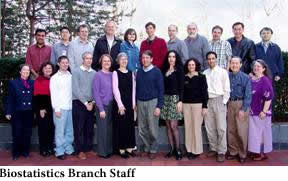Overview
 The Biostatistics Branch develops statistical methods and data
resources to strengthen observational studies, intervention trials, and laboratory investigations
of cancer. The Branch also
provides information on cancer rates for generating etiologic leads and developing appropriate study
designs, and it plans and conducts independent and collaborative descriptive and analytic studies of
cancer etiology. Members of the Branch consult and collaborate with scientists throughout the NCI
and NIH, and with investigators and public health officials at other government agencies and
academic and research institutions in this country and abroad.
The Biostatistics Branch develops statistical methods and data
resources to strengthen observational studies, intervention trials, and laboratory investigations
of cancer. The Branch also
provides information on cancer rates for generating etiologic leads and developing appropriate study
designs, and it plans and conducts independent and collaborative descriptive and analytic studies of
cancer etiology. Members of the Branch consult and collaborate with scientists throughout the NCI
and NIH, and with investigators and public health officials at other government agencies and
academic and research institutions in this country and abroad.
The Branch offers opportunities for post-doctoral research in statistical methods for epidemiologic
research, genetic epidemiology, and risk assessment, and for projects in analytic and descriptive
epidemiology. Post-doctoral fellows also have an opportunity to collaborate on important epidemiologic
studies, many of which include molecular and genetic components.
Methodologic Research
Branch scientists develop methods for increasing efficiency and improving analysis of case-control
and cohort designs. High priority is being given to methodologic issues in genetic epidemiology.
Recently, Branch members developed methods for estimating risk associated with an identified
autosomal dominant gene from family studies in which one member volunteers to be genotyped
and to provide disease histories of first-degree relatives (kin-cohort design). Other research focuses
on various methods for characterizing exposure history and overcoming problems associated with
measurement error and missing information.
Descriptive Studies of Cancer
The Branch studies geographic patterns and temporal trends in cancer incidence and mortality
rates to generate etiologic hypotheses, evaluate consistency with other hypotheses, and identify
cancer sites warranting special study. Etiologic leads may also be suggested from studies of temporal
trends in cancer subsites and histologic subtypes. Branch members develop statistical methods to
interpret geographic variation, which they apply in collaborative studies to explain variations in
breast cancer rates due to differences in the prevalence of known risk factors. Recently, the Branch
published a U.S. atlas of cancer mortality data spanning the years 1950 to 1994, which identified
geographic areas with high rates of specific cancers and spatial and temporal patterns that may
suggest particular carcinogenic exposures. The atlas is available in printed and electronic formats
(http://www3.cancer.gov/atlasplus/). Branch scientists also
develop statistical methods to analyze associations of age, calendar time, and year of birth with
cancer rates. These age-period-cohort analyses found a decrease in risk of breast cancer among
black and white women born since 1948, despite later age of childbearing than in earlier cohorts
Cancer Risk Assessment
A major research thrust within the Branch is quantifying risk of developing cancer from exposure
to known carcinogens. Studies of underground miners yielded risk estimates of lung cancer from exposure
to radon, and data from a combined analysis of 11 such studies worldwide indicated that 10-12% of all U.S.
lung cancer deaths each year may be attributable to indoor radon exposure. A recent analysis of data from
eight case-control studies of exposure to radon in the home yielded risk estimates consistent with those
from studies of underground miners. Branch scientists also developed a model for predicting the risk of
breast cancer over a defined time interval for a woman with specific risk factors, such as a strong family
history. This model has been used to assist in counseling women and to define eligibility criteria for
intervention studies, such as the NCI Breast Cancer Prevention Trial. The model has also be used to
help assess risks and benefits of tamoxifen for preventing breast cancer in high risk women. Recent
work quantified the risk of melanoma from exposure to ultraviolet radiation based on personal
history of residence.
Collaborative Studies
Branch investigators are key participants in large, complex interdisciplinary studies of cancer
etiology and risk assessment. In a recent example, they were major collaborators in a case-control
study of children with acute lymphoblastic leukemia, which found that risk was not associated with
exposure to electromagnetic fields (EMF). Statistical elements of the study included assessing the
validity of exposure measurements, designing and analyzing reliability studies, and evaluating
dose-response relationships. Branch investigators led analyses of hormone assays to determine
their reliability for studies aimed at understanding the etiology of hormone-related cancers.
Branch investigators collaborate on more than one hundred interdisciplinary projects with
scientists at the National Cancer Institute and worldwide.